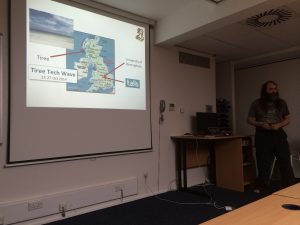Applications for this post are now closed.
Teaching Fellow in Computer Science – SB1407
Description School of Computer Science, Salary: £31,342 – £37,394 per annum pro rata,
Start: 1 September 2014 or as soon as possible thereafter, Fixed term for 9 months
Details Applications are invited for a Teaching Fellowship in the School of Computer Science. In the first instance, at least, this is a fixed-term position of nine months with a start date of September 2014. We require a Teaching Fellow to assist with the development and delivery of high quality, innovative teaching. Applicants should have at least a BSc in Computer Science, preferably a PhD, and previous lecturing and tutorial experience at undergraduate level. Preferably they should also be able to demonstrate ability to deliver a range of core Computer Science courses, in particular within the field of HCI, in classroom, laboratory and small-group tutorial environments; experience in the development of innovative material for learning and teaching; and/or experience of contributing to pedagogical studies in the sciences.
Candidates are welcome to make informal enquiries to the School’s Director of Teaching, Dr Graham Kirby, dot-cs@st-andrews.ac.uk.
This post is for 9 months, starting 1 September 2014 or as soon as possible thereafter
Please quote ref: SB1407
Closing Date: 7 August 2014
Further Particulars: SB1407AO FPs.pdf
School of Computer Science
Salary: £31,342 – £37,394 per annum pro rata
Start: 1 September 2014 or as soon as possible thereafter
Fixed term for 9 months
News
Jakub Dostal from SACHI and external co-authors published a paper at this year’s DIS conference. The paper was awarded the best paper award, given to the top 1% papers at the conference. This paper is one of the outcomes of a Dagstuhl seminar on Proxemics in Human-Computer Interaction, which Aaron Quigley helped organise and which was attended by several SACHI members.
Dark Patterns in Proxemic Interactions: A Critical Perspective.
Saul Greenberg, Interactions Lab, Department of Computer Science, University of Calgary
Sebastian Boring, Department of Computer Science, University of Copenhagen
Jo Vermeulen, Expertise Centre for Digital Media, Hasselt University
Jakub Dostal, School of Computer Science, University of St Andrews
Abstract:
Proxemics theory explains peoples’ use of interpersonal distances to mediate their social interactions with others. Within Ubicomp, proxemic interaction researchers argue that people have a similar social understanding of their spatial relations with nearby digital devices, which can be exploited to better facilitate seamless and natural interactions. To do so, both people and devices are tracked to determine their spatial relationships. While interest in proxemic interactions has increased over the last few years, it also has a dark side: knowledge of proxemics may (and likely will) be easily exploited to the detriment of the user. In this paper, we offer a critical perspective on proxemic interactions in the form of dark patterns: ways proxemic interactions can be misused. We discuss a series of these patterns and describe how they apply to these types of interactions. In addition, we identify several root problems that underlie these patterns and discuss potential solutions that could lower their harmfulness.
More details about the paper can be found in the ACM Digital Library
On the 19th of June, 2014, the group went out on an excursion to the Isle of May, just off the coast of Anstruther. It was the perfect time to visit, with beautiful weather all day long, and with what we were told to be a quarter of a million birds, as it was the middle of the nesting season. That was actually quite believable, as we saw entire cliff faces covered in birds nested as our ferry, the May Princess, toured round the island: there were puffins, seagulls, ducks, swans, terns – and even a few seals. We enjoyed hiking round the island and photographing the birds for close to three hours. The serene environment gave us a wonderful opportunity to step out of our offices/labs into the bright sunshine and taste the wind and sea – and to embrace the wonders of Mother Nature. As we were getting on and off the boat, we also had quite the “in the wild” experience, when the terns, who were nesting in the mini-harbour area, attacked us in droves, dive-bombing us from overhead to warn us off! We ended the day with an unforgettable meal of Fish and Chips from the famous Anstruther Fish Bar, and with smiles and happy memories! [Photo Credits: Michael Mauderer, Shyam Reyal, Article By: Martin McCaffery]
<!–Speaker: Aaron Quigley and Daniel Rough, University of St Andrews
Date/Time: 12-1pm May 20, 2014
Location: Jack Cole 1.33a–>
Title: AwToolkit: Attention-Aware User Interface Widgets
Authors: Juan-Enrique Garrido, Victor M. R. Penichet, Maria-Dolores Lozano, Aaron Quigley, Per Ola Kristensson.
Abstract: Increasing screen real-estate allows for the development of applications where a single user can manage a large amount of data and related tasks through a distributed user inter- face. However, such users can easily become overloaded and become unaware of display changes as they alternate their attention towards different displays. We propose Aw- Toolkit, a novel widget set for developers that supports users in maintaing awareness in multi-display systems. The Aw- Toolkit widgets automatically determine which display a user is looking at and provide users with notifications with different levels of subtlety to make the user aware of any unattended display changes. The toolkit uses four notifica- tion levels (unnoticeable, subtle, intrusive and disruptive), ranging from an almost imperceptible visual change to a clear and visually saliant change. We describe AwToolkit’s six widgets, which have been designed for C# developers, and the design of a user study with an application oriented towards healthcare environments. The evaluation results re- veal a marked increase in user awareness in comparison to the same application implemented without AwToolkit.
Title: An Evaluation of Dasher with a High-Performance Language Model as a Gaze Communication Method
Authors: Daniel Rough, Keith Vertanen, Per Ola Kristensson
Abstract: Dasher is a promising fast assistive gaze communication method. However, previous evaluations of Dasher have been inconclusive. Either the studies have been too short, involved too few partici- pants, suffered from sampling bias, lacked a control condition, used an inappropriate language model, or a combination of the above. To rectify this, we report results from two new evaluations of Dasher carried out using a Tobii P10 assistive eye-tracker machine. We also present a method of modifying Dasher so that it can use a state-of-the-art long-span statistical language model. Our experi- mental results show that compared to a baseline eye-typing method, Dasher resulted in significantly faster entry rates (12.6 wpm versus 6.0 wpm in Experiment 1, and 14.2 wpm versus 7.0 wpm in Exper- iment 2). These faster entry rates were possible while maintaining error rates comparable to the baseline eye-typing method. Partici- pants’ perceived physical demand, mental demand, effort and frus- tration were all significantly lower for Dasher. Finally, participants significantly rated Dasher as being more likeable, requiring less concentration and being more fun.
This seminar is part of our ongoing series from researchers in HCI. See here for our current schedule.
 Earlier this year we held the SACHI Logo Contest. To decide on the outcome we formed a jury of 10 people, consisting of 5 academic and 5 student members of SACHI. We are pleased to announce that the best student design for our logo contest was submitted by Jason T. Jacques, which you can see to the left. Both the academic and students members of the jury selected Jason’s logo as the best student design.
Earlier this year we held the SACHI Logo Contest. To decide on the outcome we formed a jury of 10 people, consisting of 5 academic and 5 student members of SACHI. We are pleased to announce that the best student design for our logo contest was submitted by Jason T. Jacques, which you can see to the left. Both the academic and students members of the jury selected Jason’s logo as the best student design.
The logo submitted by Uta Hinrichs, while not eligible for the student prize, was the top ranked entry and has been chosen as the logo to represent SACHI going forward. Congratulations to both Jason and Uta! You can see Uta’s logo options below which we will be adding to our website (once redesigned in the months ahead). We also apologise to both Uta and Jason for reducing their submissions into these blog worthy thumbnails which do neither justice.
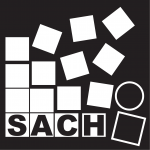
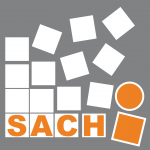
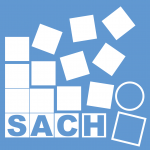
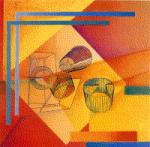
Members of SACHI are presenting a number of papers and other works at this year’s AVI 2014 the International Working Conference on Advanced Visual Interfaces May 27 – 30, 2014 – Como, Italy.
“Started in Rome in 1992, AVI has become a biannual appointment for a wide international community of experts with a broad range of backgrounds. Through more than two decades, the Conference has contributed to the progress of Human-Computer Interaction, offering a forum to present and disseminate new technological results, new paradigms and new visions for interaction and interfaces. AVI 2014 offers a strong scientific program that provides an articulated picture of the most challenging and innovative directions in interface design, technology, and applications. World leading researchers from industry and academia will present their work. 25 different countries are represented in 3 workshops, 32 long papers, 17 short papers, 29 posters, and 14 hands-on demos.”
The schedule below will allow you to see a sample of the Human-Computer Interaction research at the University of St Andrews.
- Wednesday, 14.00 AVI Posters and Demos
“An End-User Interface for Behaviour Change Intervention Development”,
D. Rough and A. Quigley (Univ . of St. Andrews, UK) - Thursday May 29, 2014, 8: 45 – 10.30 Paper Session Room A.2.1 Connection and Collaboration
“Paper vs. Tablets: The Effect of Document Media in Co – located Collaborative Work” [PDF] ( Full Paper)
J . Haber, S . Carpendale (Univ . of Calgary, Canada); M . Nacenta (Univ . of St. Andrews, UK) - Thursday May 29, 2014 11:00 – 12:40 Paper Sessions Room A.3 Evaluation Studies
“An Evaluation of Dasher with a High – Performance Language Model as a Gaze Communication Method” [PDF] (Full Paper)
D. Rough, P.O. Kristensson (Univ . of St. Andrews, UK); Keith Vertanen (Monta na Tech, USA) - Thursday, 15:15 – 16: 30 AVI 2014 Best Papers presented at Villa Erba, Lake Como
“AWToolkit: Attention Aware Interface Widgets” [PDF] (Full Paper)
J. E. Garrido Navarro, V.M. R. Penichet, M. D. Lozano (Univ. de Castilla – La Mancha, Spain); A. Quigley, P. O. Kristensson (Univ . of St. Andrews, UK) (Best Paper)
Finally, on Friday May 30th Aaron will be the session chair for Interface Metaphors + Social Interaction session at 9am.


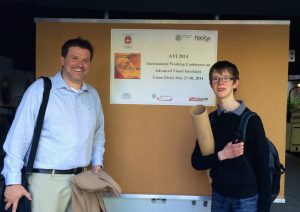
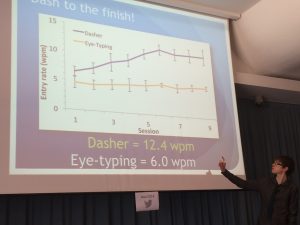

Members of SACHI are presenting a number of papers and other works at this year’s CHI in Toronto, Canada. The schedule below will allow you to see a sample of the Human-Computer Interaction research at University of St Andrews.
Paper (Honourable Mention): Depth Perception with Gaze-contingent Depth of Field
Session: The Third Dimension
When: Monday 11:40-12:00
Where: 718AB
Teaser Video
Interactivity: Text Blaster: A Multi-Player Touchscreen Typing Game
When: Monday 17:30-19:30
Where: Exhibit Hall E
Teaser Video
Paper (Best Paper): RetroDepth: 3D Silhouette Sensing for High-Precision Input On and Above Physical Surfaces
Session: On and Above the Surface
When: Tuesday 11:00-11:20
Where: Exhibit Hall G
Teaser Video
AltCHI Paper: None of a CHInd: Relationship Counselling for HCI and Speech Technology
Session: Limits and Futures
When: Tuesday 11:20-11:40
Where: 717AB
Teaset Video
Paper: Modeling the Perception of User Performance
Session: User Models and Prediction
When: Tusday 14:00-14:20
Where: 801A
Teaser Video
TOCHI Paper: Complementing Text Entry Evaluations with a Composition Task
Session: Text Entry and Evaluation
When: Wednesday 9:40-10:00
Where: Exhibit Hall G
Teaser Video
Paper: Uncertain Text Entry on Mobile Devices
Session: Text Entry and Evaluation
When: Wednesday 10:00-10:20
Where: Exhibit Hall G
Teaser Video
SIG: The Usability of Text Entry Systems Now and in the Future
When: Wednesday 11:00-12:20
Where: 715A
Paper: Quantitative Measurement of Virtual vs. Physical Object Embodiment through Kinesthetic Figural After Effects
Session: Multitouch Interaction
When: Wednesday 14:40-15:00
Where: 718AB
Teaser Video
Aaron Quigley was an associate chair for the Interaction Using Specific Capabilities or Modalities sub-committee and Per Ola Kristensson was an associate chair for the Interaction Techniques and Devices sub-committee. While Aaron Quigley was a session chair, Jakub Dostal and Michael Mauderer were Student Volunteers throughout the conference.

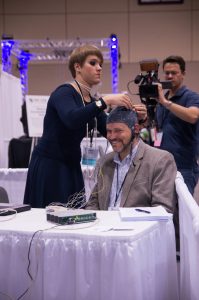
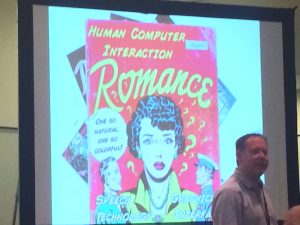
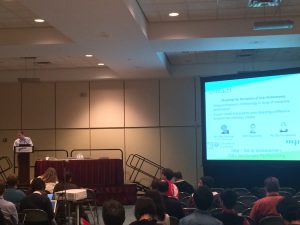
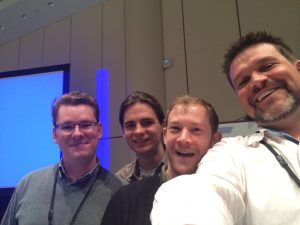
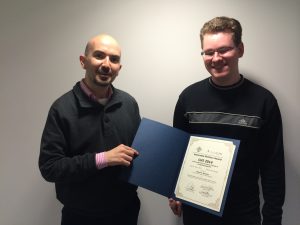
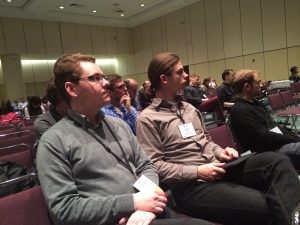
<!–Speaker: Alan Dix, Birmingham University
Date/Time: 2-3pm May 6, 2014
Location: Maths Lecture Theatre B, University of St Andrews–>
Abstract:
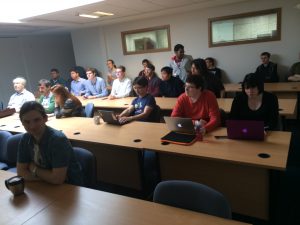 From buying plane tickets to eGovernment, participation in consumer and civic society is predicated on continuous connectivity and copious computation . And yet for many at the edges of society, the elderly, the poor, the disabled, and those in rural areas, poor access to digital technology makes them more marginalised, potentially cut off from modern citizenship. I spent three and half months last summer walking over a thousand miles around the margins of Wales in order to experience more directly some of the issues facing those on the physical edges of a modern nation, who are often also at the social and economic margins. I will talk about some of the theoretical and practical issues raised; how designing software with constrained resources is more challenging but potentially more rewarding than assuming everyone lives with Silicon Valley levels of connectivity.
From buying plane tickets to eGovernment, participation in consumer and civic society is predicated on continuous connectivity and copious computation . And yet for many at the edges of society, the elderly, the poor, the disabled, and those in rural areas, poor access to digital technology makes them more marginalised, potentially cut off from modern citizenship. I spent three and half months last summer walking over a thousand miles around the margins of Wales in order to experience more directly some of the issues facing those on the physical edges of a modern nation, who are often also at the social and economic margins. I will talk about some of the theoretical and practical issues raised; how designing software with constrained resources is more challenging but potentially more rewarding than assuming everyone lives with Silicon Valley levels of connectivity.
Bio:
Alan is Professor of Computing at University of Birmingham and Senior Researcher at Talis based in Birmingham, but, when not in Birmingham, or elsewhere lives in Tiree a remote island of the west coast of Scotland.
Alan’s career has included mathematical modelling for agricultural crop sprayers, COBOL programming, submarine design and intelligent lighting. However, he is best known for his work in Human Computer Interaction over three decades including his well known HCI textbook and some of the earliest work in formal methods, mobile interaction, and privacy in HCI. He has worked in posts across the university sector as well as a period as founder director of two dotcom companies, aQtive (1998) and vfridge (2000), which, between them, attracted £850,000 of venture capital funding. He currently works part-time for the University of Birmingham and is on the REF Panel for Computer Science. He also works part-time for Talis, which, inter alia, provides the reading list software used at St Andrews.
His interests and research methods remain, as ever, eclectic, from formal methods, to technical creativity and the modelling of regret. At present he is completing a book, TouchIT, about physicality in design, working with musicologists on next generation digital archives, envisioning how learning analytics can inform and maybe transform university teaching, and working in various projects connected with communication and energy use on Tiree and rural communities.
Last year he completed a walk around Wales as an exploration into technical issues ‘at the edge’, the topic of his seminar.
This seminar is part of our ongoing series from researchers in HCI. See here for our current schedule.
As part of the Man to Machine Health and Technology Series, Professor Aaron Quigley will be giving a talk on “Independent living now and in 2070 – Information and communications technology and ageing” on April the 14th in Seminar Room 1 of the Medical School (location) from 5.15pm – 6.30pm. Further details of the event are here.
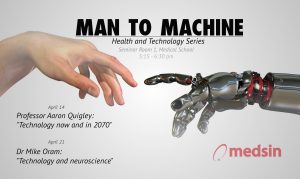

Congratulations to Uta Hinrichs and Aaron Quigley on the launch of their trading consequences project. Trading Consequences charts the commercial growth of the British Empire and it details the economic and environmental impact of shipping valuable commodities such as building materials, tea, fruit and spices. This is the culmination of two years of effort in which eleven million pages of text were processed, resulting in a 150 gigabyte database. People can explore our visualisations, generated from the data, which help to make the historical findings more accessible. Sources included British and Canadian Government documents, newspapers from around the world, books and journals.
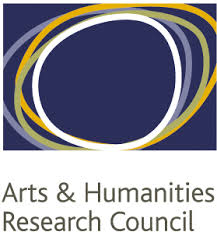 The project has been led by the University of Edinburgh in collaboration with the Universities of St Andrews and Saskatchewan and York University, Canada. The EDINA national data centre at University of Edinburgh has stored information garnered in the study. The two-year project forms part of Digging into Data, a wider initiative by Jisc, the UK’s digital information body. The work is supported by the Arts and Humanities Research Council, Economic and Social Research Council and the Canadian Social Sciences and Humanities Research Council.
The project has been led by the University of Edinburgh in collaboration with the Universities of St Andrews and Saskatchewan and York University, Canada. The EDINA national data centre at University of Edinburgh has stored information garnered in the study. The two-year project forms part of Digging into Data, a wider initiative by Jisc, the UK’s digital information body. The work is supported by the Arts and Humanities Research Council, Economic and Social Research Council and the Canadian Social Sciences and Humanities Research Council.To find out more, please go to: http://tradingconsequences.blogs.edina.ac.uk/





